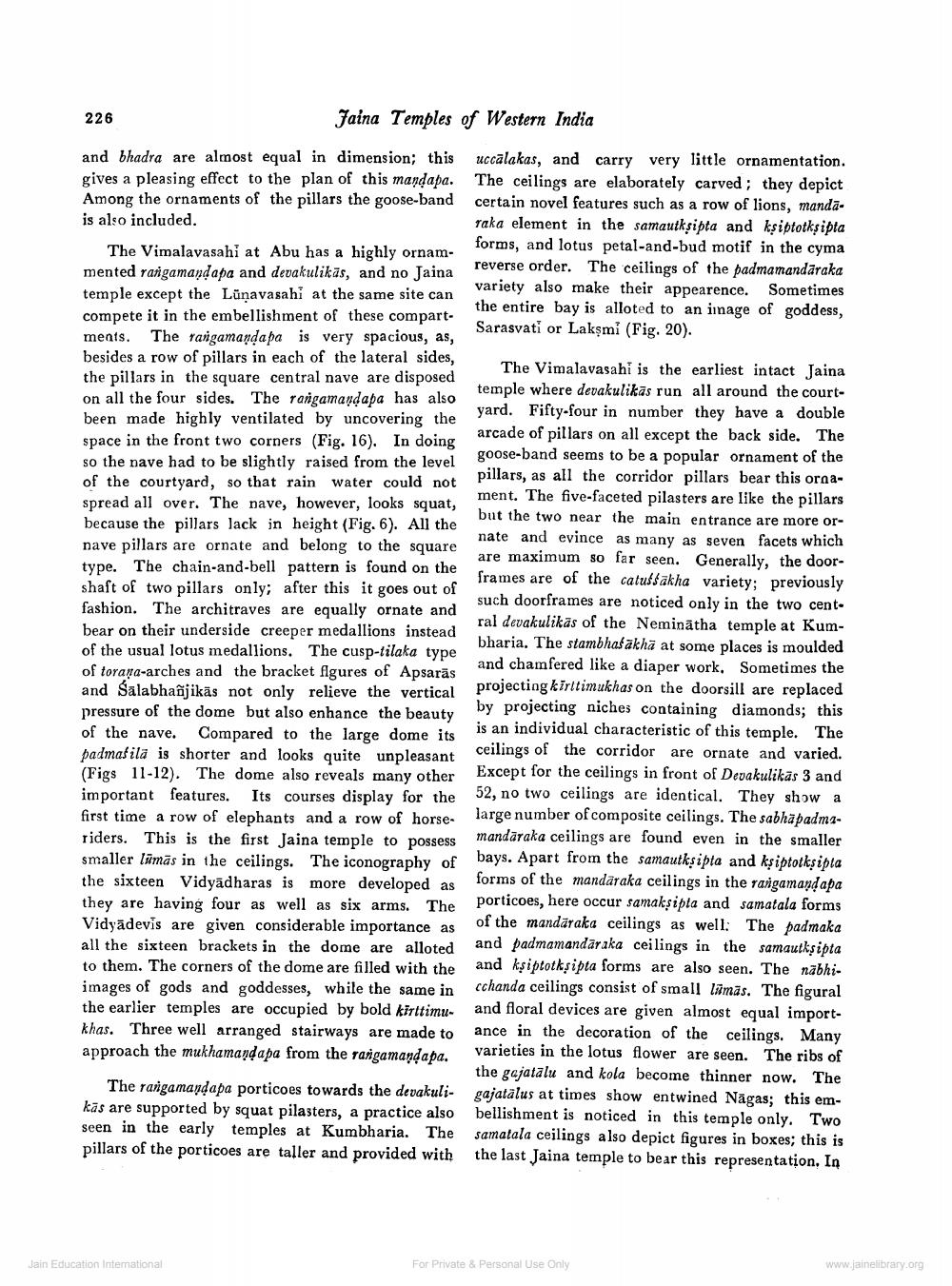________________
226
Jaina Temples of Western India
uccalakas, and carry very little ornamentation. The ceilings are elaborately carved; they depict certain novel features such as a row of lions, mandaraka element in the samautk sipta and ksiptotks ipta forms, and lotus petal-and-bud motif in the cyma reverse order. The ceilings of the padmamandaraka variety also make their appearence. Sometimes the entire bay is alloted to an inage of goddess, Sarasvati or Lakşmi (Fig. 20).
and bhadra are almost equal in dimension; this gives a pleasing effect to the plan of this mandapa. Among the ornaments of the pillars the goose-band is also included.
The Vimalavasahi at Abu has a highly ornammented rangamandapa and devakulikās, and no Jaina temple except the Lunavasahi at the same site can compete it in the embellishment of these compartments. The tangamanda pa is very spacious, as, besides a row of pillars in each of the lateral sides, the pillars in the square central nave are disposed on all the four sides. The rangamandapa has also been made highly ventilated by uncovering the space in the front two corners (Fig. 16). In doing so the nave had to be slightly raised from the level of the courtyard, so that rain water could not spread all over. The nave, however, looks squat, because the pillars Jack in height (Fig. 6). All the nave pillars are ornate and belong to the square type. The chain-and-bell pattern is found on the shaft of two pillars only; after this it goes out of fashion. The architraves are equally ornate and bear on their underside creeper medallions instead of the usual lotus medallions. The cusp-lilaka type of torama-arches and the bracket figures of Apsarās and Salabhañjikās not only relieve the vertical pressure of the dome but also enhance the beauty of the nave. Compared to the large dome its padmašila is shorter and looks quite unpleasant (Figs 11-12). The dome also reveals many other important features. Its courses display for the first time a row of elephants and a row of horses riders. This is the first Jaina temple to possess smaller lämās in the ceilings. The iconography of the sixteen Vidyadharas is more developed as they are having four as well as six arms. The
ix arme the Vidyadevis are given considerable importance as all the sixteen brackets in the dome are alloted to them. The corners of the dome are filled with the images of gods and goddesses, while the same in the earlier temples are occupied by bold kirttimu- khas. Three well arranged stairways are made to approach the mukhamandapa from the rangamandapa.
The Vimalavasahi is the earliest intact Jaina temple where devakulikās run all around the courtyard. Fifty-four in number they have a double arcade of pillars on all except the back side. The goose-band seems to be a popular ornament of the P pillars, as all the corridor pillars bear this oroament. The five-faceted pilasters are like the pillars but the two near the main entrance are more ornate and evince as many as seven facets which are maximum so far seen. Generally, the doorframes are of the catussakha variety; previously such doorframes are noticed only in the two central devakulikās of the Neminātha temple at Kumbharia. The stambhafakha at some places is moulded and chamfered like a diaper work. Sometimes the projecting kiritimukhas on the doorsill are replaced by projecting niches containing diamonds; this is an individual characteristic of this temple. The ceilings of the corridor are ornate and varied. Except for the ceilings in front of Devakulikas 3 and 52, no two ceilings are identical. They show a large number of composite ceilings. The sabhapadmamandāraka ceilings are found even in the smaller bays. Apart from the samautks ipta and kşiptotksipla forms of the mandāraka ceilings in the rangamandapa porticoes, here occur samaksipla and samatala forms of the mandaraka ceilings as well. The badmaka and padmamandaraka ceilings in the samautksipta and ksiptotksipta forms are also seen. The nabhicchanda ceilings consist of small limas. The figural and floral devices are given almost equal importance in the decoration of the ceilings. Many varieties in the lotus flower are seen. The ribs of the gajatalu and kola become thinner now. The gajatalus at times show entwined Nāgas; this embellishment is noticed in this temple only. Two samatala ceilings also depict figures in boxes; this is the last Jaina temple to bear this representation. In
The rangamandapa porticoes towards the devakuli- kās are supported by squat pilasters, a practice also seen in the early temples at Kumbharia. The pillars of the porticoes are taller and provided with
Jain Education International
For Private & Personal use only
www.jainelibrary.org




